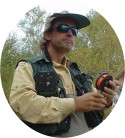One of the clearest earmarks of a resourceful fly caster is the life he transmits to his line and leader. A live, dynamic line that can adapt to the stream's myriad configurations is the one and only key to giving your fly all the freedom it needs. Without that autonomy, the chances of your imitation being taken for a real fly are almost zero. |
 My feeling is that the most interesting and graceful things in fly casting happen just after you stop the rod at the end of the forward cast (and during some summer evenings in the green meadows along alluring mountain brooks). Just then or in the split second afterwards, you can imprint the desired shape or pattern onto your line. Hopefully, when this ephemeral pattern comes to rest on the water and before the currents completely wash it out, it will accomplish its mission.
My feeling is that the most interesting and graceful things in fly casting happen just after you stop the rod at the end of the forward cast (and during some summer evenings in the green meadows along alluring mountain brooks). Just then or in the split second afterwards, you can imprint the desired shape or pattern onto your line. Hopefully, when this ephemeral pattern comes to rest on the water and before the currents completely wash it out, it will accomplish its mission.
What you don't achieve in the air, don't expect to do on the water. In others words, mending line on the water can never replace aerial mends or presentation casts. It can only complement them because, without an aerial mend, the time elapsing between the line's landing and the on-the-water mend is almost always too long to successfully avoid dragging. By the time the line touches the water, you want to have got most of your mending done. It's the only way to keep out of drag trouble. Another important reason for keeping the number and size of your on-the-water mends to a minimum is the danger of making noise or splashing when you pick up the line for a mend. That can put your trout down almost as surely as a drag.
Besides, the magnificence of some patterns in the air outshines any line configuration on the water. Take it from me. The esthetics of fly casting is more than a simple matter of personal taste.


